All issues

Volume 22 (2003)
- Issue 3-4 Pages 3-4_5・・・
- Issue 1-2 Pages 1-2_1・・・
Volume 22, Issue 3-4
Displaying 1-1 of 1 articles from this issue
- |<
- <
- 1
- >
- >|
Review
-
Tetsuya SUGIYAMAArticle type: Review
2003Volume 22Issue 3-4 Pages 3-4_5-3-4_12
Published: February 25, 2004
Released on J-STAGE: March 28, 2015
JOURNAL FREE ACCESSThe only established therapy for glaucoma is to reduce intraocular pressure (IOP). Nevertheless, some cases with glaucoma progress in spite of sufficient control of IOP. It seems that future glaucomatous agents should be evaluated for actions other than their IOP reducing effect, including neuroprotective and ocular circulation-improving effects. For evaluation of IOP reducing effect, we use ocular hypertension models : the water-loading, alpha-chymotrypsin-induced, laser-induced and corticosteroid-induced models, etc. For assessment of neuroprotection, visual field measurement is recognized as the most important in the case of humans. Protective effects are tested on cultured retinal ganglion cells in basic experiments. Image analysis of optic nerve head, pathohistological assessment, and electrophysiological examinations including visual evoked potentials are used in animal experiments. Retina or optic nerve damage models include axotomy of optic nerve, ischemia-reperfusion, light-induced, NMDA-induced model etc. Classical methods for measurement of ocular circulation include a hydrogen gas clearance and microsphere methods. Recently, laser Doppler method, color Doppler imaging and laser speckle method have been used in experimental and clinical situations. Endothelin-induced, nitric oxide synthase inhibitor-induced models or electrical stimulation of optic nerve are used as ocular circulation disorder models.View full abstractDownload PDF (813K)
- |<
- <
- 1
- >
- >|